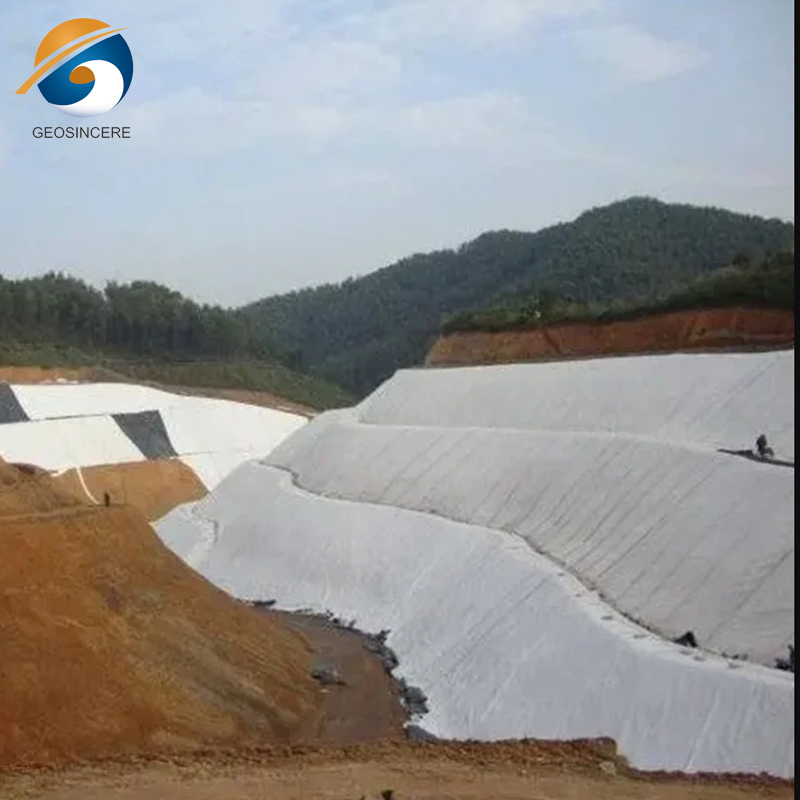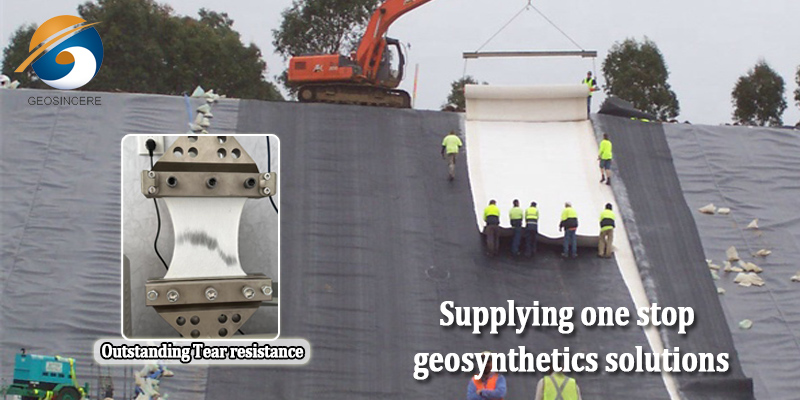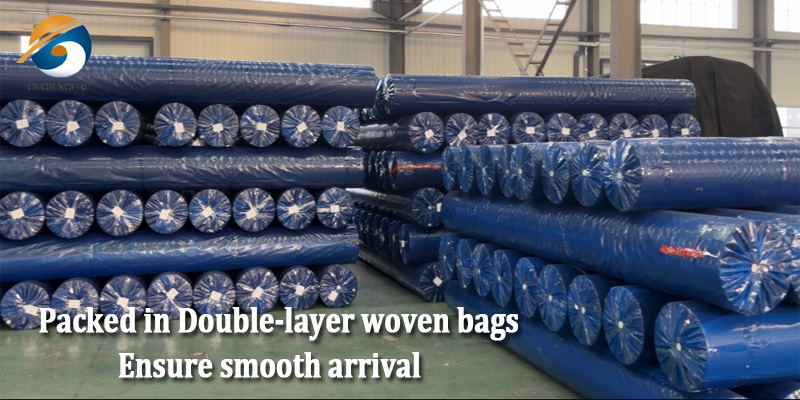Geosynthetic Needle Punched Nonwoven Geotextile Fabric
Geosynthetic needle-punched nonwoven geotextile fabric is a specialized material used in civil engineering and construction applications. It is designed to provide reinforcement, filtration, separation, and drainage functions in various geotechnical projects.
Geotextile fabric acts as a filter by allowing water to pass through while preventing the movement of fine particles or soil. It helps to retain soil in erosion control applications and provides stable drainage pathways.Geotextiles are used to separate different soil layers or materials with varying properties. By placing the fabric between dissimilar materials, it prevents intermixing and maintains the stability and functionality of each layer.Geotextile fabric can enhance the strength and load-bearing capacity of soils. It is often used in applications like road construction, embankments, and retaining walls to improve soil stability, distribute loads, and reduce the potential for settlement.
Geosynthetic needle-punched nonwoven geotextile fabric is a type of synthetic material commonly used in civil engineering and environmental applications. It is designed to provide various functions and properties that enhance the performance and longevity of geotechnical structures.Geotextiles are typically made from polypropylene or polyester fibers that are mechanically bonded through a needle-punching process. The fibers are interlocked using barbed needles, creating a nonwoven fabric with a three-dimensional structure.
The fabric acts as a filtration medium, allowing water to pass through while preventing the migration of fine particles. It helps in retaining soil particles, preventing their erosion and maintaining the stability of soil structures.Geotextiles are used to separate different materials, such as soil and aggregate layers, in construction projects. It prevents the intermixing of materials, enhances load distribution, and improves the overall performance of the structure.Geotextiles with appropriate permeability can serve as a drainage layer. They allow the passage of water while preventing the clogging of soil particles. This helps in managing excess water, reducing hydrostatic pressure, and enhancing the stability of the structure.
Geotextiles can provide reinforcement to weak soils or aggregate layers. By distributing loads and reducing stress concentrations, they enhance the load-bearing capacity of the soil and improve the overall stability of the structure.Geotextiles are used in erosion control applications such as slope stabilization and shoreline protection. They help in preventing soil erosion by dissipating the energy of flowing water and promoting vegetation growth.Geotextiles play a crucial role in environmental protection measures. They can be used in landfill liners, waste containment systems, and other applications that require the isolation and containment of hazardous materials.
Geosynthetic needle-punched nonwoven geotextile fabric comes in various thicknesses, strengths, and permeabilities to suit different project requirements. It is widely used in road construction, embankments, retaining walls, landfills, drainage systems, and other geotechnical and civil engineering applications.
Parameter
Item | Test Method | Unit | 10 | 15 | 20 | 25 | 30 | 35 | 40 | 45 | 50 | 60 |
Index Properties | ||||||||||||
Ultimate Tensile Strength. MD | ASTM D4595 | KN/m | 1 | 11 | 14 | 17 | 19 | 24 | 27 | 30 | 37 | 41 |
Ultimate Tensile Strength, TD | ASTM D4595 | KN/m | 6 | 10 | 12 | 15 | 17 | 21 | 25 | 28 | 34 | 38 |
Tensile Elongation | ASTM D4595 | % | 45 | 45 | 50 | 50 | 50 | 60 | 60 | 60 | 60 | 60 |
Grab Tensile Strength. MD | ASTM D4632 | N | 400 | 600 | 850 | 1000 | 1250 | 1450 | 1700 | 1900 | 2100 | 2500 |
Grab Tensile Strength, TD | ASTM D4632 | N | 350 | 550 | 700 | 900 | 1100 | 1250 | 1450 | 1600 | 1800 | 2150 |
Grab Elongation | ASTM D4632 | % | 45 | 45 | 50 | 50 | 50 | 60 | 60 | 60 | 60 | 60 |
Trapezoid Tear Strength. MD | ASTM D4533 | N | 160 | 300 | 350 | 430 | 490 | 540 | 630 | 710 | 770 | 920 |
Trapezoid Tear Strength, TD | ASTM D4533 | N | 140 | 270 | 330 | 400 | 450 | 510 | 610 | 690 | 750 | 900 |
CBR Puncture Strength | ASTM D6241 | N | 1000 | 1800 | 2300 | 2700 | 3200 | 3600 | 4400 | 4800 | 5800 | 6900 |
Apparent Opening Size 090 | ASTM D4751 | mm | 0.12 | 0.11 | 0.11 | 0.10 | 0.09 | 0.08 | 0.08 | 0.08 | 0.08 | 0.08 |
Water Flow Q100 | ASTM D4491 | L/m2/s | 250 | 235 | 220 | 200 | 185 | 165 | 125 | 110 | 90 | 80 |
Weight | ASTM D5261 | G/m2 | 100 | 150 | 200 | 250 | 300 | 350 | 400 | 450 | 500 | 600 |
Thickness | ASTM D5199 | mm | 1.2 | 1.8 | 2.3 | 2.9 | 3.2 | 3.6 | 3.9 | 4.2 | 4.4 | 4.8 |
Roll width | / | m | 6 | 6 | 6 | 6 | 6 | 6 | 6 | 6 | 6 | 6 |
Roll Length | / | m | 300 | 200 | 150 | 100 | 100 | 100 | 80 | 80 | 50 | 50 |
Geosynthetic Needle Punched Nonwoven Geotextile Fabric for Sale Features
High tensile strength: Geosynthetic needle-punched nonwoven geotextile fabric offers excellent strength and durability, making it suitable for demanding applications.
Chemical and biological resistance: It is resistant to deterioration caused by chemicals, microorganisms, and ultraviolet (UV) radiation, ensuring long-term performance.
Easy installation: Geotextile fabric is lightweight and easy to handle, making installation more efficient.
Cost-effective: By improving the performance and longevity of geotechnical structures, geotextiles can help reduce maintenance and repair costs over time.
Overall, geosynthetic needle-punched nonwoven geotextile fabric plays a vital role in various civil engineering projects by providing reinforcement, filtration, separation, and drainage capabilities. Its versatility and effectiveness make it a valuable material in the construction industry.
Applications of Geosynthetic Needle Punched Nonwoven Geotextile Fabric
Geosynthetic needle-punched nonwoven geotextile fabric is a versatile material that finds application in various civil engineering and environmental projects. Some of the common applications of this fabric include:
Separation: Geotextile fabric is used to separate different layers of soil or aggregate materials with varying particle sizes. It prevents the mixing of these layers, thereby maintaining the integrity and performance of the engineered structure.
Filtration: The fabric acts as a filtration layer, allowing water to pass through while preventing the movement of fine particles. It is commonly used in drainage systems, retaining walls, and erosion control applications to ensure proper water flow and filtration.
Erosion Control: Geotextiles are used to stabilize soil and prevent erosion in areas that are prone to erosion, such as slopes, embankments, and riverbanks. By providing reinforcement and retaining soil particles, they help in reducing soil loss and maintaining the stability of the slopes.
Drainage: Geotextiles with high permeability are used in drainage applications to facilitate the flow of water while preventing the movement of soil particles. They are commonly employed in road construction, sports fields, and landfills to enhance drainage efficiency.
Reinforcement: Geotextile fabric can provide reinforcement to soil structures by improving tensile strength and distributing loads. It is used in applications such as retaining walls, reinforced soil slopes, and road construction to enhance the stability and strength of the structures.
Protection: Geotextiles are utilized to protect geomembranes and other lining systems from damage during installation or from punctures caused by sharp objects. They act as a cushioning layer and minimize the risk of damage to the underlying materials.
Landfill Engineering: Geotextiles are commonly used in landfill engineering for applications such as leachate collection and gas venting systems. They help in the proper functioning and maintenance of landfill systems by providing filtration, drainage, and separation functions.
Coastal and Riverbank Protection: Geotextiles are employed in coastal and riverbank protection projects to prevent soil erosion and provide stabilization. They are used in the construction of revetments, breakwaters, and beach nourishment schemes.
Railway and Road Construction: Geotextiles are used in the construction and maintenance of railways and roads to improve their performance. They provide separation, filtration, and reinforcement functions, enhancing the overall durability and longevity of the infrastructure.
Environmental Protection: Geotextiles play a vital role in environmental protection projects such as land reclamation, wetland restoration, and contaminated site remediation. They aid in soil stabilization, water management, and filtration, contributing to sustainable environmental practices.
These are just a few examples of the applications of geosynthetic needle-punched nonwoven geotextile fabric. The versatility and functionality of this material make it a valuable component in various civil engineering and environmental projects.
Product Packing
Selling Packing:Customer's company Logo mark can be designed and added.
Outer Packing:Packed in Double-layer woven bags to ensure smooth arrival and avoid rough handling.
Transport Packing: Put in the container.
Company Profile
Shandong GEOSINO New Material Co.,Ltd (Brand:Geosincere) is the professional geomembrane and geosynthetics manufacturer and wholesaler located in Taian City, Shandong Province, PRChina. We are not a local overseas distributer, we are an professional manufacturer, exporter and wholesaler for such geosynthetic products as geomembanes, geotextiles, geogrids, geocells, geosynthetic clay liners (GCLs), drainage boards, etc. GEOSINCERE is always committed to geomembrane research and development, manufacturing and installation services. We can provide our customers with most extensive lines of geomembranes and geotextiles for civil, mining, environmental and aquaculture engineering applications.
GEOSINCERE has been keeping on investing in technological innovation, manufacturing facilities improvement and turnkey engineering abilities. We have invested 10 million dollars into our manufacturing factory which is equipped with state-of-the-art automatic production lines to manufacture high quality geomembranes and other geosynthetics with optimized processes. GEOSINCERE has over 160 employees and its own 24,000 square meters state-of-art manufacturing factory with many automatic geosynthetic production lines, professional machines and testing equipment.Our extensive lines of geosynthetics products are well known for their ensured quality, high performance, excellent durability and best cost effectiveness. GEOSINCERE brand geomembranes and other geosynthetics products and solutions can meet your requirements by our solid technologies, innovative engineering solutions and excellent customer services. GEOSINCERE always tries our best to solve the most complex civil, mining and environmental challenges with our innovative and high performance geosynthetic products. Quality assurance, factory price and fast delivery time are our competitive advantages.
Hope to be your partner!




















